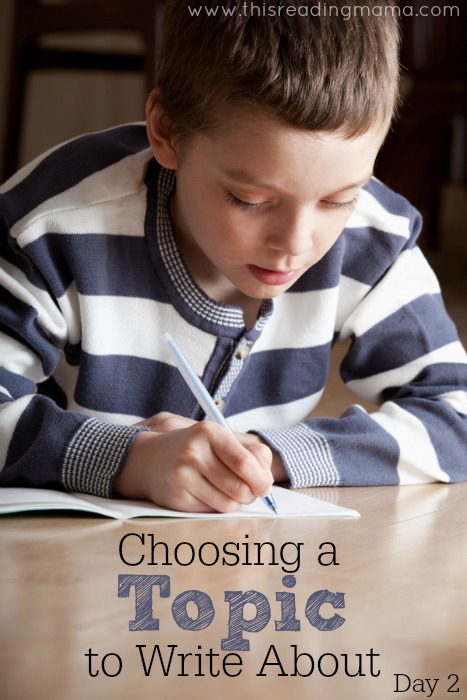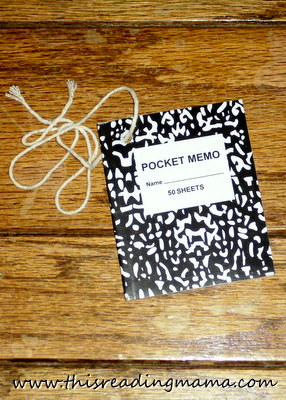Welcome to day 2 of Unleashing the WRITER in your Child, a 5-day series focused on helping you teach your young writer the craft and process of writing. I am so glad you’re here! If you missed day 1 or the intro to this 5-day series, you can click HERE or on the image below to see what we’ve talked about so far.
*This post contains affiliate links. To read more about this, please see my disclosure policy.
Yesterday, we talked about modeling the writing life to your child. Among all the suggestions, I’d have to say that the most powerful tool is modeling your life as a writer; letting your child hear your thoughts as you compose- be it a grocery list, a letter to a neighbor, a poem, or an article for a local magazine. Today, my thoughts shift to helping young writers find a topic. Not just any topic either. One that they are passionate about and can write to. Choosing a topic is indeed a process in and of itself. And an important one as well. Before we dive too far in, I wanted to share a few really great quotes about topic choice, all from Writing: Teachers & Children at Work.
- “The easiest place for any writer to being writing, including you, is in writing about something you know.” -Graves (pg. 12)
- “The topic is the single most important factor contributing to writer variability. When the topic is ‘hot’, the child has access to an abundance of information…” -Graves (pg. 263)
- “Writers who do not learn to choose a topic wisely lose out on the strong link between voice and subject. A child writes about a topic because he things he knows something about it. ” -Graves (pg. 21)
Helping Kids Find Their Writer’s Voice
Start Simple
Authors write about things that are close to them; often using life experiences and areas of expertise. Chances are, you know your child well. Start a simple list together of the things he or she really likes. These can become topics for which she can write. The awesome thing about almost any topic is that you can adapt it to any genre. If the topic is riding horses, your little author can write a poem about it, a personal memoir about a time when she rode a horse, or instructions on how to ride a horse.
Start a Writer’s Notebook
If you’re ready to take it a step further, start a Writer’s Notebook. Ralph Feltcher explains a Writer’s Notebook as a place where you capture what moves you, what you wonder about, what you notice about life, seed ideas or “triggers”, small details, snatches of talk, memories, lists or artifacts, or writing or quotes that inspire you. On the contrast, it is not the same thing as a journal or diary. It isn’t a place to “just” record your thoughts or feelings (although these will certainly be a part of your entries).
This can be a spiral bound notebook, a composition book, or loose-leaf in a 3-ring binder. One year, I bought little composition notebooks (pictured above) for my class from the $1 store and tied a string around it. The kids carried these around for places other than the classroom. Some took them home and brought in their snippets of writing the next day. I personally carry around a composition book. This is where I jot down all my ideas for future blog posts or activities. I use the ideas, quotes, or “seeds” and grow them into full-blown drafts; eventually becoming posts right here. 🙂 {A Writer’s Notebook is a little bit like what Jack carries around in Magic Tree House books.} You can also encourage your child to carry it around with them on family trips; even to the grocery store!
There is no one way to do a Writer’s Notebook. There are as many different ways to do it as there are people. For younger children, a notebook may be a place to draw pictures that will eventually trigger writing. It may even be a place where the child writes down one word that intrigues them, a new vocabulary word perhaps.
 {photo source}
{photo source}
Try Quick Writes
I was introduced to the idea of quick writes when I took a writing instruction course for elementary and middle school. Our professor did the coolest thing! Instead of just standing and lecturing about how to teach writing, she divided up our time and we had time for independent writing. We did lots of quick writes.
A quick write is writing what happens in response to a stimulus (like a book or a field trip). An example book my professor chose was I’m in Charge of Celebrations by Byrd Baylor. After she read it, we were given about 10 minutes to write our thoughts. {This text particular text is one that I would not recommend for the younger writers, but those in later elementary and middle school.} Penny Kittle asks her students, “What struck you about what I just read? Write about it. Steal a line that you like or an idea you have, an opinion about it or just write what this piece made you think about.” Just write (or draw), no matter how incoherent the thoughts seem; just let them flow. There’s no right or wrong, no slap on the wrist for wrong spellings; just write. Let me just add here that quick writes are a great place to start if your child doesn’t like to write.
There are a couple of important things you want to keep in mind when picking the stimulus for a quick write: the stimulus is
1-age and developmentally appropriate &
2-that is resonates with your writer, with their interests. Do you have a son who loves to play sports? Find a biography about a sports hero (maybe a time in their life when they wanted to quit) and read that section. Then ask him to write his thoughts about that.
Quick writes are a great way to discover the “seeds” for writing topics. After a quick write is complete, ask young writers to go back through their quick write and look for words, phrases, or sentences that jump out at them (this won’t happen on the same day as the initial quick write). Maybe even ask them to circle those. Once they’ve discovered what appeals to them, ask them to take one of those sentences and write a little more about it. Can they spend the next 5-10 minutes writing their feelings, thoughts, connections with that sentence?
One more thing about quick writes: they are not the same and writing prompts. While there is nothing wrong with occasionally using writing prompts, quick writes allow the writer the freedom to take the stimulus where they want it to go, giving them the freedom to explore their own interests and passions. Prompts do not always allow for this freedom.
 {photo source}
{photo source}
Finding Your Writing Voice
When young writers are provided the chance to use a notebook as a writing tool and write about things that for which they are passionate, it is much easier for them to find their writing voice. What exactly does that mean?
Graves says that, “the voice is the dynamo of the writing process, the reasons for writing in the first place. The voice starts with the choice of the topic.” (pg. 31) The voice (or tone) of the writing is what makes the writing yours and not someone else’s. I remember Lucy Calkins say something like: What you write first are anybody’s words. You have to make them yours. Writers need to to learn to think, “How can I write this so that this can only be said of me?”
Voice is making your writing sound like you. This entails more than writing like we speak. If we did this, our writing would be filled with “…ums…” and circular thinking. Finding your voice doesn’t happen immediately. It takes time to develop and nurture, but one thing is for sure: topic is key. When kids can really into a piece of writing because they are passionate about it, given time and good modeling, voice becomes a by-product.
Tomorrow, we will delve a little deeper into taking those “seeds” and developing them into a rough draft or “sloppy copy”, as I like to call them.
 Don’t forget to visit the other bloggers in this iHomeschool Network 5-day series!
Don’t forget to visit the other bloggers in this iHomeschool Network 5-day series!
~Becky


I used to have my first and second graders keep writing folders. They kept all of their “seeds” in the folder until they were ready to select one and take it further on in the writing process.
I like your thoughts on voice. Young children love to tell stories about themselves.
Loving this series!
Cool, Jodie. I plan on talking about writing folders a bit more in my next post. 🙂